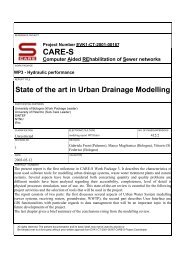Modeling
R184_CHI_Rules
R184_CHI_Rules
You also want an ePaper? Increase the reach of your titles
YUMPU automatically turns print PDFs into web optimized ePapers that Google loves.
244 Rules for Responsible <strong>Modeling</strong><br />
after the cessation of rainfall. The sensitivity of this parameter requires a range<br />
of durations and evaporation rates to describe the rainfall inter-event. The<br />
REGEN parameter is only active during dry periods and its effect on the<br />
dynamic infiltration rate is noticed when subsequent rainfall occurs after the dry<br />
period.<br />
The value for this parameter in the Redhill dataset was 0.01 s. This<br />
parameter displayed its maximum sensitivity for medium inter-event durations<br />
of 1 and 3 d. The parameter became insensitive after a duration of 6 d of no<br />
rain. The evaporation rates had no impact on the sensitivity of this parameter<br />
using peak flow as the objective function. Minimal sensitivity was seen for<br />
different evaporation rates using runoff volume as the objective function. This<br />
parameter never displayed more than a 0.7% change in any objective function<br />
for a 10% change in the variable. This parameter was directly influenced by the<br />
duration of no rain.<br />
Sensitivity of WIDTH<br />
SWMM assumes sheet flow on the subcatchment and non-linear reservoir<br />
routing. WIDTH is a measure of overland flow width for both the pervious and<br />
impervious areas. Larger subcatchment widths result in faster catchment<br />
response and are representative of highly drained areas. Smaller subcatchment<br />
widths mean longer overland flow lengths, longer response time and are<br />
representative of open areas without well defined surface and engineered<br />
drainage systems. WIDTH can be assumed to be a tuning parameter, since it<br />
controls attenuation.<br />
The value for this parameter in the Redhill dataset ranged from 2700 to<br />
39300 feet. The two corresponding subcatchments for this low and high<br />
WIDTH value had catchment areas of 595 and 2516 acres and % impervious of<br />
17.0 and 0.0 respectively. This parameter displayed its maximum sensitivity at<br />
the smallest rainfall totals and some sensitivity was seen for all rainfall depths.<br />
The parameter became less sensitive as the total volume of rainfall increased<br />
and at a depth of more than 0.50 was markedly less sensitive. This parameter<br />
was most sensitive during short duration low intensity events and short duration<br />
high intensity events. A second region of sensitivity for high intensity short<br />
events was also discovered. This is when pervious area runoff contributed to the<br />
overall peak and runoff volume totals. For the two storms of 3.5 inch/h and 0.25<br />
and 0.50 h duration the WIDTH parameter was as sensitive as it was for most<br />
intensities at the short durations. WIDTH was not sensitive for durations in<br />
excess of 3 h except for medium intensity storms with respect to the volume of<br />
runoff.<br />
Generally the parameter was sensitive when a new source of overland flow<br />
contributed to the total runoff, such as the pervious area with depression<br />
storage. At the smallest of rainfall intensities and volumes overland flow<br />
consists of only overland flow on the impervious area without any depression




